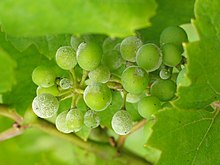Seyval noir
Seyval noir is a red hybrid grape variety that was created in the late 19th century by French horticulturalist Bertille Seyve and his father-in-law Victor Villard from a crossing of two Seibel grapes (Rayon d'Or and Seibel 5656). The pair used the same two varieties to create the white wine grape Seyval blanc, making the two siblings rather than color mutations of one or the other. The name Seyval comes from a combination of the two men's names.[1]
Unlike Seyval blanc, Seyval noir is not widely planted with only a few producers cultivating the grape in the Canadian wine region of Quebec and some experimental plantings in the Jura wine region of eastern France.[1]
History and pedigree

Seyval noir was created by French grape breeders Bertille Seyve and Victor Villard at their Saint-Vallier vineyard and nursery in the Isère department of eastern France. The grape is a crossing of two Seibel grape varieties (Rayon d'Or and Seibel 5656) produced by French grape breeder Albert Seibel. This parentage makes Seyval noir a complex hybrid, meaning that within its pedigree are genes from several Vitis species. The same crossing was used to make the white wine grape Seyval blanc, making the two varieties siblings rather than color mutations of one or the other.[1]
From its parents, Rayon d'Or (a crossing of Aramon du Gard and Seibel 405) and Seibel 5656 (a crossing of Seibel 4595 and Seibel 4199), Seyval noir has Vitis vinifera, Vitis rupestris and Vitis aestivalis genes in lineage.[2][3]
Viticulture

Seyval noir is moderately winter-hardy vine which is able to survive the cold winters and late springs of Quebec. The grape is also fairly resistant to most grape diseases but does have some susceptibility to powdery mildew.[1]
Wine regions
While Seyval noir was created in France, the grape is hardly planted here. It is not listed on the country's official registry of wine grape varieties nor is it permitted for use in any Appellation d'Origine Contrôlée (AOC) wines. Some experimental plantings of the grape do exist at Domaine Ganevat in the commune of Rotalier in the Jura wine region of eastern France where it is used in a blend for a nouveau table wine. Outside France the grape is planted to a limited extent in Quebec where it used for both red and rosé wines as well as vinegar production.[1]
Synonyms
As a relatively recently created hybrid, Seyval noir does not have many synonyms with only the breeding code Seyve-Villard 5247 generally recognized.[1]
References
- ^ a b c d e f J. Robinson, J. Harding and J. Vouillamoz Wine Grapes - A complete guide to 1,368 vine varieties, including their origins and flavours pg 991 Allen Lane 2012 ISBN 978-1-846-14446-2
- ^ Vitis International Variety Catalogue (VIVC) Rayon d'Or Accessed: May 27th, 2013
- ^ Vitis International Variety Catalogue (VIVC) Seibel 5656 Accessed: May 27th, 2013
